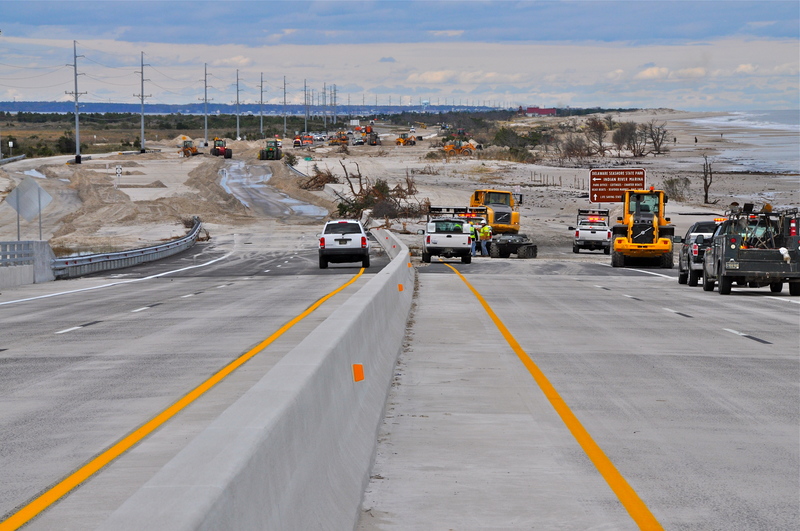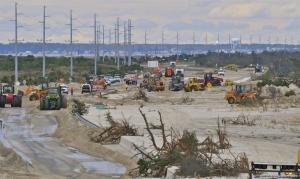DNREC: More sand needed to protect Route 1
Tons of sand blocked the southbound approaches to Route 1 at the foot of Indian River Inlet bridge following Superstorm Sandy, but state officials say it will take much more sand to protect the road from future storms.
Department of Natural Resources and Environmental Control Secretary Collin O'Mara says 1 million cubic yards of sand is needed to rebuild the dune and widen the beach on the north side of the inlet. That's three times more than the amount of sand used in two resorts during a recent coastal replenishment project.
State officials have offered varied estimates as to the amount of sand removed from Route 1 after Sandy, from as little as 25,000 cubic yards to as much as 175,000 cubic yards of sand.
Using aerial photographs, Delaware Department of Transportation engineers estimate about 25,000 cubic yards of sand washed over a half-mile stretch of the highway. O'Mara says his agency estimates the total is closer to 125,000 to 175,000 cubic yards washed on the roadway, with just as much sand washed into the ocean.
No matter what the actual number is, officials agree on one thing: It will take much more sand to rebuild the beach and protect access to the bridge. O'Mara said building a 100-foot dune and 200-foot wide beach could take as much as 1 million cubic yards of sand, more than three times the 261,000 cubic yards of sand pumped onto the beaches in Rehoboth Beach and Dewey Beach during the most recent replenishment project.
As Sandy churned off the coast Oct. 27 into Oct. 29, waves and storm surge breached the roadway in several places about one-half mile from the base of the bridge north along Route 1. In at least two locations, the ocean water and sand washed into the marshes on the west side of the road. DelDOT officials closed the road early Oct. 28, and it remained closed for a week.
At least a half mile of dunes was lost, said Frank Piorko, director of DNREC's Division of Watershed Stewardship.
DelDOT engineer and project manager Sarah Criswell said it's estimated the sand was nearly 3 feet deep on the northbound lanes of Route 1 for 2,150 feet. On the southbound lanes, the sand was about 1 foot deep, but in another section of about 650 feet, sand was 3 feet deep.
It took crews from DNREC, DelDOT, a private contractor and the National Guard more than four days working sunrise to sunset to move the sand off Route 1 in order to reopen the bridge to traffic.
More work needed to fix beach
But, more work is needed to provide an adequate buffer between the Atlantic Ocean and Route 1 on the sand-starved beach north of the Indian River Inlet.
Tony Pratt, administrator of DNREC's Shoreline and Management Section, said the storm draws attention to an ongoing problem. “The status quo has been a sand deficit to begin with,” he said. He said the U.S. Army Corps of Engineers would play the lead role in any sand replenishment project. Pratt said state officials would likely request additional sand from outside sources through the corps. “It needs immediate attention,” he said, adding the area has never been part of a beach replenishment project.
He said the beach on the north side of the inlet should have a 100-foot-wide dune with a 200-foot-wide beach, similar to Rehoboth Beach before the storm, to provide protection to Route 1 and the bridge.
Pratt said DNREC and corps staff are in the process of taking surveys to determine how much sand eroded and how much sand remains in order to make plans for the future. Funding will be requested as part of a supplemental request for federal disaster relief aid for projects to repair damage caused by Superstorm Sandy. O'Mara said Delaware officials are working with officials from New York, New Jersey and Connecticut. “If Delaware were asking on its own for the corps to be authorized to replenish the beach near the bridge, it would be a complicated process,” O'Mara said. “But hopefully with all the states working together, something can get done.”
O'Mara said the role of the corps since the 1980s has been to provide engineering support – not beach replenishment – in the area of the Indian River Inlet. He said federal authorization would be required to replenish the beach.
Dan Brower, program manager in DNREC's Waterways and Shoreline Management Section, said the natural flow of sand along the Delaware's Atlantic shoreline is from south to north. Jetties constructed in the 1930s to stabilize Indian River Inlet interrupt the natural flow so sand builds up on the south side of the inlet. A sand bypass pumping system with pipes running from the south side of the inlet across the bridge to the north side is used by DNREC to widen the north-side beach.
The pumping operation moves more than 100,000 cubic yards of sand annually across the bridge to rebuild the state park dunes and beach north of the inlet, Brower said. O'Mara said no sand is pumped during the summer season but that policy could be revisited. Once the beach is widened, O'Mara said, moving 200,000 cubic yards of sand each year would better maintain the beach.
Douglass Robb, DelDOT bridge engineer, said DelDOT and DNREC staff are both working on a plan to provide better protection for the northern Route 1 approach to the bridge. He said DelDOT is looking at a project using a buried corrugated metal sheet piling to protect an 800- to 1,000-foot-long section of roadway just north of the bridge.
O'Mara says restoring Prime Hook marsh is critical
Funding for beach replenishment near Indian River Inlet bridge would compete with a proposed $20 million request from the state to replenish the beach and dunes at Fowler Beach in Prime Hook National Wildlife Refuge. Breaches in the dunes allow tidal flow of saltwater from the Delaware Bay into freshwater marshes and have destroyed marshland that once provided protection for the nearby community of Primehook Beach.
Superstorm Sandy not only widened the breaches, but also deepened them exacerbating the flooding problem and leaving the beach community more vulnerable.
DNREC Secretary Collin O'Mara said the requested funds would be enough to close the breaches and begin marsh restoration, which he said is paramount in stabilizing the area. “We have to add sediment and plant with saltwater tolerant plants,” he said. “Marsh restoration on the scale of what is needed has not often been undertaken here.”
He said there are examples of large-scale marsh restoration – in some cases assisted by private funding – along the banks of the Mississippi River and Gulf Coast after Hurricane Katrina and the BP oil spill.
O'Mara said no matter what action is taken, the prognosis for coastal areas with delicate ecosystems such as Prime Hook Refuge is not good. “Over the next couple generations, we're going to have a lot of problems,” he said.

























































